
Page 60: of Marine Technology Magazine (September 2014)
Ocean Observation: Gliders, Buoys & Sub-Surface Networks
Read this page in Pdf, Flash or Html5 edition of September 2014 Marine Technology Magazine
was retrieved at the end of the trial, the sensors’ critical surfaces protected by
UV-Xchange were not the only surfaces free of fouling. The camera sphere – sit- uated over 30 cm from the nearest UV-
Xchange – had a large clean patch due to receiving incidental UV light. Although
AML’s UV technology has a conserva- tive effective range listing of “up to 10 cm” depending on environmental condi- tions, the contact with the camera sphere demonstrated the reach extends further in certain situations.
Through the use of their Folger Pin- nacle platform, Ocean Networks Cana- da has played a key role in the testing of UV biofouling control. Tom Dakin,
Sensor Technologies Development Offi - cer at ONC, is looking forward to seeing the effect this technology will have on ocean monitoring:
Biofouling is obviously a problem on our ocean observing systems. Poison is an undesirable mitigation strategy due to the long term environmental implica- tions. Repeated manual cleaning is ex- pensive and wipers are effective only on limited surfaces. The announcement of a UV antifouling system was therefore greeted with interest, but cautiously.
A technology demonstration was car- ried out by comparing a poison protect- ed Seabird CTD to UV protected AML
Oceanographic CTDs and an unpro- tected CTD. The results after 8 months were conclusive. The UV protection was as effective as the poison but had the benefi t of being able to protect exter- nal surfaces as well as areas exposed to moving water. Based on the sensor pro- tection success we are now eager to try this technique on camera lenses.
In another demonstration, Micro-X instruments with UV-Xchange installed were delivered to Fastwave Communi- cations in Australia to protect hydrocar- bon sensors used to detect oil. Retrofi t to the sensors without any modifi cations required, AML’s UV technology was the only antifouling method suitable for keeping clean the sensors’ inlets due to their complex geometry. Rapid foul- ing of the sensors necessitates sending crews out often to clean off the heavy growth. UV-Xchange is expected to dra- matically reduce these maintenance re- quirements, resulting in substantial cost savings. Two months into the deploy- ment, Nick Daws, Director of Business
Development at Fastwave, is pleased with the technology’s performance:
Due to the biofouling problems en- countered in Australian waters, Perth based company Fastwave has been test- ing the AML UVX modules in local wa- ters. Initial results look very promising, and when this fi rst stage of evaluation is completed, testing will be moved to the tropical North West coast of Australia, where the most aggressive biofouling problems occur, particularly in the sum- mer months as sea temperatures rise.
Fastwave has deployed a substantial number of marine environmental moni- toring systems in this region, and reduc- ing the impact of biofouling on sensors will deliver signifi cant benefi ts in terms of reduced sensor maintenance require- ments. Successful deployments around the world in locations such as Canada, the United States, Australia, and Dubai have proven UV to be an effective anti- foulant in a wide range of environments.
At the time of writing this, several other deployments around the world are in the early stages.
Since the technology’s debut at Ocean- ology International in London, over-
Cabled UV with the Duty Cycle Control- ler offers full customization to accom- modate unique power budget and ap- plication requirements.
September 2014
MTR #7 (50-65).indd 60 8/27/2014 10:55:21 AM

 59
59

 61
61
